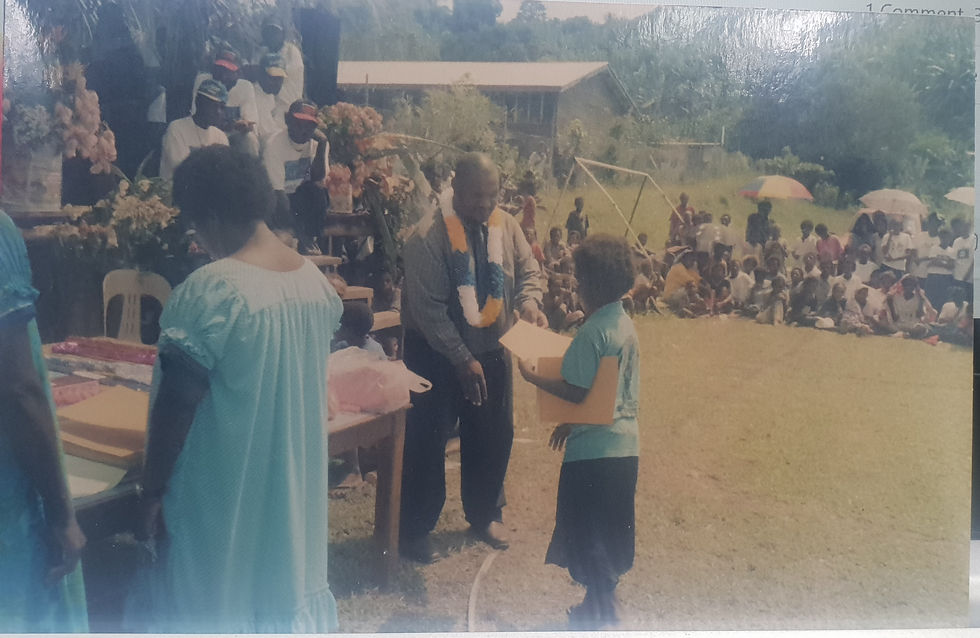Two Girls, One Plaque, and the PNG-Australia Partnership
- cynthiananareng
- Sep 20
- 3 min read
I was a 9 year old and in third grade in 2002 when my elder sister and I went to the dentist at the Kimbe General Hospital one day. A new wing was recently completed that housed the dentist, consultant clinic and a kiosk. The waiting line was long and my sister wandered off to see the hospital grounds. When she came back, she excitedly told me to look towards the front of the hospital where there was a plaque. I was not able to make out what was written and she whispers excitedly.. "The inscription reads, from the people of Australia to the people to PNG." To two young girls in a small town in Papua New Guinea, the sentence felt like personal and we were touched to have been gifted the facility.
A few years later doing sixth grade in 2005, the 30th Independence anniversary was coming up and a group of us gathered one day at recess for a chat. We were looking at the signage on a shipping container that was in the middle of the school yard. It was being used for storage but must have been used to bring in some items a few years ago. The container still bore the sign "Australian Aid". One of my friends looked at that signage and said "if we're truly independent why do we still depend receive aid?" That thought stayed with me as it was in that same year that I read articles on the Boomarang Aid and about how the Governor of Morobe, Luther Wenge, spoke against the Enhanced Cooperation Program. My perception of the relationship changed and I wondered who were the real beneficiaries of such development assistance.
Fast forward to ten years later, I graduated from University and joined the PNG Department of Foreign Affairs. I started learning more about the PNG-Australia relationship through engagements as a Foreign Service Officer where I worked in the Bilateral Division in the Pacific, Australia and New Zealand Branch. I began to understand the higher level engagements that guided the relationship between the two countries. In 2019, when negotiations started on the Comprehensive Strategic Economic Partnership (CSEP) between PNG and Australia and I was fortunate to play a supporting role in that process. This partnership was signed in 2020, replacing the Joint PNG-Australia Partnership of 2013. This document signified the relationship between the two countries moving into a partnership and moving away from the donor-recipient relationship.
A few years later, I left the Foreign Service and joined a DFAT funded program that provided Monitoring and Evaluation services to their Health and Education portfolios in PNG. That experience revealed to me just how intricate the relationship between the two countries are. You almost cannot attribute the contribution of an intervention to change because the support were to core services and across sectors. When conducting interviews, you would have interviewees referring to other Australian supported programs from the past and from other sectors and you would to pick their responses apart to be able to understand the aspects referring to the program in question.
Now working in yet another DFAT funded program that is involved in implementation you get to see how the CSEP is being implemented through the six pillars of cooperation. As time passed, both Governments have learned and improved their ways of working. Australian Aid is no longer referred to as aid but rather the partnership language has come into play. It is preferred to have activities implemented through the Government systems discouraging parallel systems and consultations have become an important part of the cooperation.
On the eve of the 50th year of Independence of PNG, more than twenty years from that day my sister read those beautiful words, we are both working with DFAT funded programs in PNG. I read a recent article by Ian Kemish, a former Australian High Commissioner to PNG where he says.. "Australia's job is to be that friend that shows up steady and delivers." It is an evolving relationship that is here to stay and we have to do our part to improve as we journey along.
Just as that plaque once made two young girls feel seen, I hope today’s partnership continues to inspire belief, pride, and purpose in the hearts of Papua New Guineans and Australians.




Comments